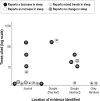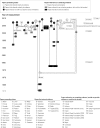A review of evidence for the claim that children are sleeping less than in the past
- PMID: 21532959
- PMCID: PMC3079945
- DOI: 10.1093/sleep/34.5.651
A review of evidence for the claim that children are sleeping less than in the past
Abstract
Study objectives: The notion that children are sleeping less than they used to is widespread. This study examined the strength of the evidence for this idea by tracing a "scholarly genealogy" of the claims presented within the literature.
Design: A systematic review of peer-reviewed literature was conducted to identify claims of a secular trend in children's sleep. For each identified claim, the references cited were reviewed.
Measurements and results: The review identified 51 studies. Of these, 17 evinced evidence (2 reported increases, 3 reported no change, 6 reported mixed trends, 6 reported decreases) and 34 provided statements without evidence. Although the evidence that sleep duration has declined is contested, all 34 studies reported a decline. Examination of the references cited revealed that 17 papers referred directly to studies which provided evidence, 4 papers referred indirectly to studies which provided evidence, 9 papers did not provide any evidence and 4 papers referred to studies which could not be located. Of the papers that did provide evidence, 85% referred to one of 3 sources of evidence, each of which was of moderate quality.
Conclusions: The genealogy of the notion of secular declines in children's sleep reveals a limited scientific basis. The apparent evidence base is inflated by repeated references to the same sources of evidence, reference to secondary sources, mis-referencing, and a failure to cite contrary evidence.
Keywords: Sleep; adolescents; bias; children; trends.
Figures



References
-
- Gangwisch J, Malaspina D, Boden-Albala B, Heymsfield S. Inadequate sleep as a risk factor for obesity: Analyses of the NHANES I. Sleep. 2005;28:1289–96. - PubMed
-
- Walsh J, Dement W, Dinges D. Sleep medicine, public policy, and public health. In: Kryger M, Roth T, Dement W, editors. Principles and practice of sleep medicine. Philadelphia: Elsevier/Saunders; 2005. pp. 648–56.
-
- Ferrara M, De Gennaro L. How much sleep do we need? Sleep Med Rev. 2001;5:155–79. - PubMed
-
- Smedje H. Trends in the duration of school-day sleep among 10-to 15-year-old South Australians between 1985 and 2004. Acta Paediatr. 2008;96:954–5. - PubMed
-
- Kronholm E, Partonen T, Laatikainen T, et al. Trends in self-reported sleep duration and insomnia-related symptoms in Finland from 1972 to 2005: A comparative review and re-analysis of Finnish population samples. J Sleep Res. 2008;17:54–562. - PubMed
Publication types
MeSH terms
LinkOut - more resources
Full Text Sources
Miscellaneous

